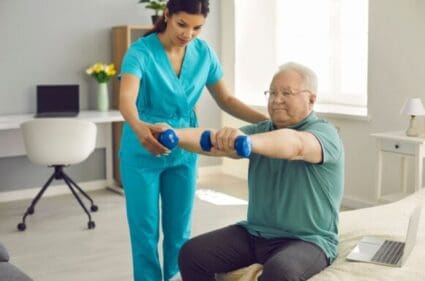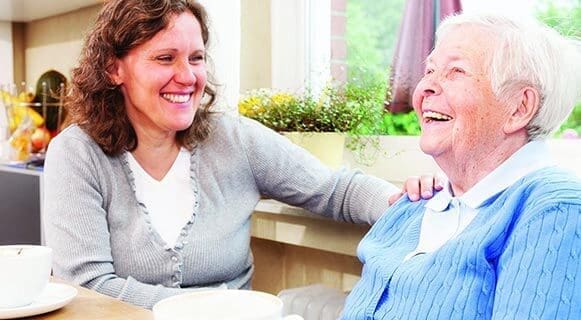What happens during a stroke?
Firstly, on this page, we talk about the presentation of strokes and then talk about stroke care at home. A mini-stroke, otherwise known as a transient ischaemic attack (TIA), happens when the blood supply to a part of the brain is cut off. The resulting lack of oxygen to the brain results in the damage, or in some cases the death, of certain brain cells. Strokes can also be caused by bleeding in the brain, and these are called haemorrhagic strokes.
The effects of having a stroke can vary greatly from person to person depending on the type and severity of the attack – as does the chance of making a full recovery. Amongst other things, your loved one may require assistance with the following as part of the stroke recovery process:
-
Mobility and Stroke Care
Mobility covers a range of areas but stroke aftercare will involve mostly help getting around the home and venturing outside for trips or other social activities. Some people may find walking very difficult. They can also be prone to tripping or falling, particularly in areas of risk such as the bathroom or the stairs.
If your loved one has had a stroke, having a live-in carer on hand to help can not only make life a lot easier but also provide reassurance to friends and family members who may worry about the person’s safety. Professional stroke aftercare can provide peace of mind for family members that there is always someone around to provide support for your relative in their time of need. Live-in carers are trained to assist with mobility aids, prevent falls, and create a safe living environment.
-
Muscle, joint, and nerve problems
Individuals often experience weakness in one side of the body, or may not be able to move at all. This can cause pain, along with a reduced ability to eat, bathe, dress, and use the toilet. After a stroke, care at home means a live-in carer will be able to assist with all aspects of personal care. They can help with exercises to improve strength and flexibility, facilitate physiotherapy sessions, and ensure that your loved one remains as comfortable and independent as possible.
-
Thinking and planning
The stroke recovery process often involves the simplest of routines suddenly becoming extremely challenging. This is often because the person can struggle to think clearly, or reason with their thoughts. Sleep patterns, memory, and overall behaviour can be affected, so the individual will require support with many daily tasks. After a stroke, care at home means your loved one can recover in the familiarity of their settings, reducing additional confusion caused by a new environment. Live-in carers can provide structured routines, assist with cognitive exercises, and help manage daily activities, ensuring your loved one receives consistent and compassionate care.
-
Stroke Care for Speech
Following a stroke, individuals may suffer from aphasia, meaning they find it difficult to find a word or phrase in a sentence. Some can have trouble speaking altogether. Though in many cases a professional speech therapist will be able to assist. Talking and interacting with other people regularly, and without judgement, is vital to the stroke recovery process. Professional care from specialist live-in carers can include exploring different means of communication during the recovery phase. Live-in carers can support speech therapy exercises, encourage conversation, and use alternative communication methods such as picture boards and technology to facilitate interaction.
Live-in carers are specialists in-home care for stroke victims and can help daily. Along with a speech professional, they can also help explore other means of communication during the recovery phase.
-
Depression and anxiety
During post-stroke care, it’s common for people to experience low mood and anxiety. Action must be taken to reduce negative thoughts and remain positive throughout the road to recovery. Live-in carers can provide emotional support, companionship, and engage your loved one in activities that boost their mood and confidence. They can also monitor mental health closely and liaise with healthcare professionals to ensure appropriate interventions are in place.
Live-in carers can spend time getting to know your loved one so that they can understand and address any concerns. Post-stroke care at home means a live-in carer can provide personalised care and one-to-one support. This is rarely the case within hospitals or care home environments.
-
Frustration at your new circumstances
When someone has experienced a stroke, it’s normal for them to feel angry. They can no longer live life in the same way they had before. Engage a live-in carer who will remain calm, compassionate and empathetic. In times of distress or frustration, this can make all the difference to your loved one and those close to them. Live-in carers are trained in providing emotional support and can help your loved one navigate the complexities of their new circumstances with patience and understanding.
After stroke care and your next steps…
Knowing how to care for someone following a stroke can be challenging, but we can help you find the right carer. Live-in care can provide peace of mind that your loved ones are safe in their own homes. Want to know more about your care options? Contact our friendly team today or call us on 0330 053 5014.




